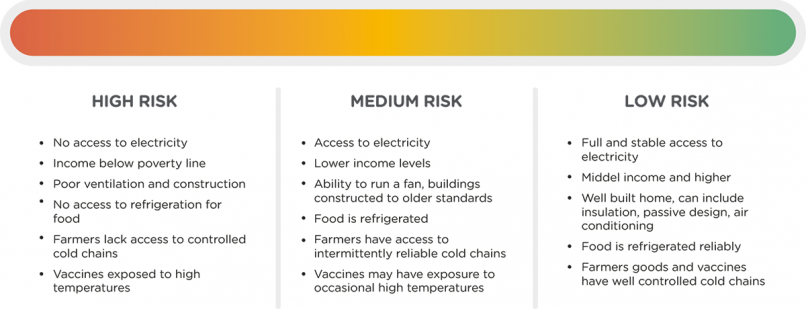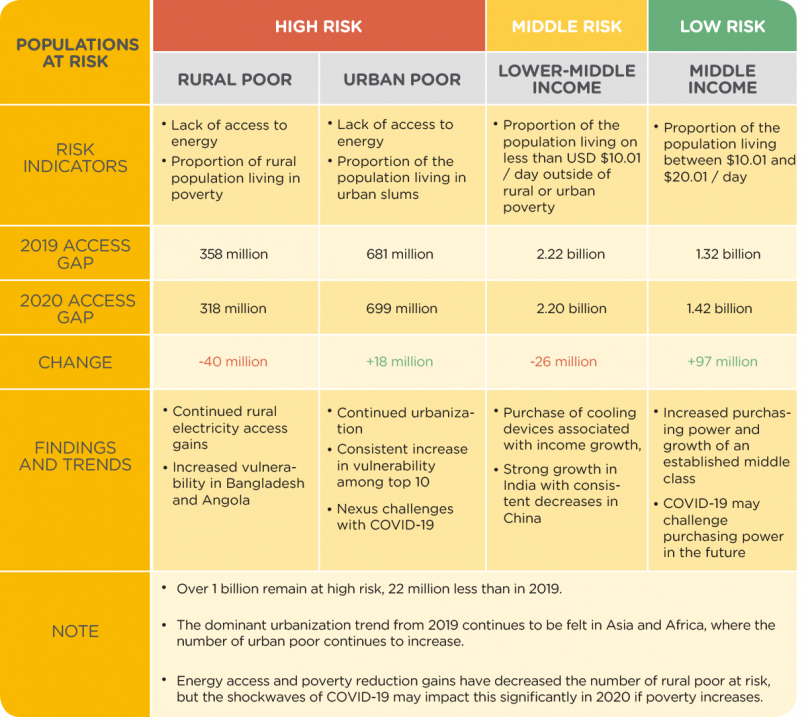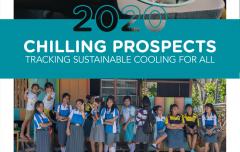Global access to cooling in 2020
The analysis for 2020 shows that across 54 high-impact countries 1.02 billion people among the rural and urban poor remain at high risk. A further 2.2 billion lower-middle income people pose a different kind of risk: they will soon be able to purchase the most affordable air conditioner or refrigerator, but price sensitivity and limited purchasing options mean they favour devices that are likely to be inefficient, threatening energy systems and resulting in increased GHG emissions.
Spectrum of risks in high-temperature environments
As governments across the globe respond to the COVID-19 pandemic, extreme heat continues to increase, threatening immediate public health and safety, as well as the long-term economic recovery from the pandemic. Intolerable levels of heat and humidity, previously forecast for mid-century, were already occurring prior to 2020, and more than doubled in their frequency between 1979 and 2017. [1]
Existing forecasts are also being challenged, and current projections are that intolerable heat will become worse without drastic action to combat climate change, including in seven South Asian countries that are home to 1.5 billion people where the number of days with extreme heat could rise from 45 days annually now to 78 days in 2050. [2]
Vaccination campaigns have stalled during the pandemic, with 13.5 million people in Least Developed Countries (LDCs) having already missed routine vaccinations by 3 April 3 2020. [3] Significantly higher rates of poverty and malnutrition are forecast through 2020. Taken together with the challenges of social and physical distancing during extreme heat, 2020 has highlighted the need to deliver sustainable cooling as a means of underpinning the recovery from the pandemic, as well as achieving the Sustainable Development Goals (SDGs) by 2030.
The Chilling Prospects series tracks immediate vulnerability to a lack of access to cooling, identifying populations at risk whose lack of access threatens their immediate health and safety. It models risk on the basis of a spectrum of access to cooling that crosses human safety and comfort, food and nutrition security and agriculture, and health services for four populations: the rural poor, the urban poor, the lower-middle income, and the middle income.
In 2020, a significant reduction in the number of the rural poor was driven by increased access to electricity in India but was partially offset by an increase in the number of urban poor, who are also at high risk from a lack of access to cooling.
Compared to 2019, the analysis shows a decrease of approximately 22 million people who are at high risk of a lack of access to cooling, from 1.04 billion to just under 1.02 billion. The number of urban poor at high risk has grown by approximately 18 million from 681 to 699 million, while the rural population has decreased by approximately 40 million from 358 million to 318 million. The lower-middle income population has decreased, but only slightly, from 2.22 billion in 2019 to 2.20 billion in 2020. Across the 54 high-impact countries, at least 3.2 billion people still face cooling access challenges, with only minor improvements noted between 2019 and 2020.
Analysis of risk from a lack of access to cooling
Note: figures may not sum due to rounding







